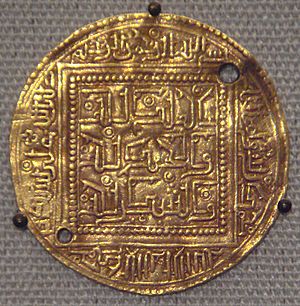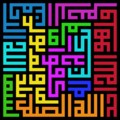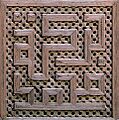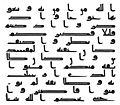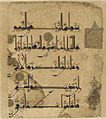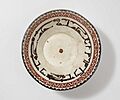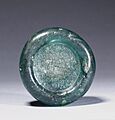Kufic facts for kids
The Kufic script (Arabic: الْخط الْكوُفِي) is an old and important style of Arabic script. It became very popular early on for writing copies of the Quran (the holy book of Islam) and for decorating buildings. Kufic script gets its name from the city of Kufa in Iraq, where it developed.
This script is known for its sharp, straight lines and angular shapes. It often looks very horizontal. There are many different kinds of Kufic script, like square Kufic, which looks like blocks, and other styles with flowers or knots. Sometimes, people in Europe even copied the look of Kufic script for decoration, even if they didn't understand the Arabic words. This is called pseudo-Kufic.
Contents
History of Kufic Script
How Kufic Script Started
In the early days of Islam, artists who wrote beautifully, called calligraphers, used different ways to write down the Quran. Arabic calligraphy quickly became a very important part of Islamic art. These calligraphers created the Kufic style.
Kufic is the oldest style of Islamic calligraphy. It comes from Kufa, a city in southern Iraq that was a major center for learning long ago. Kufic is known for its very angular shapes. It was first used for early copies of the Quran. Some experts believe the name "Kufic" was first used by a scholar named Jacob George Christian Adler. Kufic script was very important in the history of Islamic calligraphy because it was one of the first styles to truly show art and beauty in writing. The rules for Kufic script, especially its angular and straight shapes, stayed mostly the same for a long time.
How Kufic Script Was Used
The Quran was first written in a simple, slanted style. But as its text became more official, a stronger, more formal script was needed. This led to the development of what we now call Primary Kufic script.
Kufic was widely used in manuscripts from the 7th to the 10th centuries. Around the 8th century, it was the most important Arabic script. It had a serious, low look with a strong horizontal feel. Kufic was the main script used to copy the Quran until about the 11th century. Professional copyists used a special form of Kufic for the oldest surviving copies of the Quran, which were written on parchment (animal skin) between the 8th and 10th centuries. Kufic script often used decorative elements, unlike the Thuluth script, which avoided decorations and instead used vowel marks.
What Kufic Script Looks Like
Kufic script often looks like it's made of geometric shapes, with straight lines and sharp angles. It uses many vertical and horizontal strokes. At first, Kufic script didn't have dots or other marks to tell similar-looking letters apart. For example, the letters "t," "b," and "th" might have looked the same. However, Kufic script is still used in Islamic countries today.
In later Kufic Qurans from the 9th and early 10th centuries, the titles of the chapters (called suras) were often written in gold. They sometimes had a decorative leaf shape extending into the margin. Writing Kufic script on manuscripts with great care helped it develop. Even though Kufic manuscripts didn't have ruled lines, the writers achieved amazing precision. The pages usually had a set number of lines that were perfectly straight and evenly spaced.
A famous example is the Blue Quran, an early Quran manuscript written in gold Kufic script on parchment dyed a deep blue. It was likely made for a very powerful and wealthy ruler because it was so expensive and artistic to create. The gold writing on the blue background made it look incredibly grand.
Kufic Script as Decoration
Ornamental Kufic became a key part of Islamic art as early as the 8th century. It was used for Quran chapter headings, inscriptions on coins, and important public writings. You can find Kufic script on fabrics, coins, pottery, and buildings.
Coins were very important in the development of Kufic script. The letters on coins became very straight, and curves turned into perfect circles by the year 86 AH (around 705 CE). For example, Kufic script is often seen on coins and buildings made by the Seljuk Turks and on early Ottoman coins. Its decorative look led to its use on many public and private buildings in Turkey before the modern era. The current flag of Iraq (since 2008) also includes the word "takbir" (God is Greatest) written in Kufic script.
Similarly, the flag of Iran (since 1980) has the takbir written 22 times in white square Kufic script along the edges of its green and red stripes. Kufic inscriptions were also important in textiles, often appearing as decorative bands called tiraz. These tiraz inscriptions, usually in Kufic or a flowery Kufic style, often included the name of God or the ruler. For instance, the famous inscription inside the Dome of the Rock in Jerusalem is written in Kufic.
Square or geometric Kufic is a very simple, rectangular style often used in tiling. In Iran, sometimes entire buildings are covered with tiles that spell out sacred names like God, Muhammad, and Ali in square Kufic. This technique is called banna'i. There's also "Pseudo-Kufic" or "Kufesque," which are copies of Kufic script made in Europe during the Middle Ages or Renaissance. These imitations often emphasized the straight and angular strokes of Kufic.
Square Kufic
Square Kufic (Arabic: ٱلْكُوفِيّ ٱلمُرَبَّع), sometimes called banna'i (بَنَائِيّ, meaning "masonry" script), is a very simple Arabic writing style that appeared in the 12th century. Square Kufic was first used in Iranian architecture, where bricks and tiles acted like pixels to form the letters. The main goal of this script wasn't always to be easy to read.
A Syrian calligrapher named Mamoun Sakkal said that Square Kufic was a big step towards making Kufic styles simpler, as earlier styles had become more complex.
-
Geometric Kufic sample of Surah 112 (a chapter of the Quran), read clockwise, starting at the bottom left.
-
The word "Allah" in red on the white band and the takbir written 11 times in Square Kufic script in white, on the green and red bands of the Flag of Iran.
Recently, Square Kufic has become more popular for decorations like clocks, frames, and logos for Islamic businesses. It's even used in Arabic calligraphy competitions. There's a careful way to create Square Kufic calligraphy that keeps the basic shapes of Arabic letters accurate. This allows the finished artwork to be judged for its quality, not just seen as an abstract design.
How Square Kufic is Arranged
While Square Kufic can be written in many ways, there are three common arrangements:
Free Flow
This is like normal writing but uses pixel-like Arabic letters. The overall shape isn't limited by any boundary. While simple, it's not often used for finished artworks because other styles look more artistic. Free flow is mostly used as a starting point before creating more complex designs.
Linear
In this style, the writing goes from right to left, but it stays within a fixed height, forming a continuous rectangle. The letters and their dots must be exactly one pixel apart. Linear Square Kufic is good for writing long texts, like Quranic verses, along the inside edges of mosque walls.
Spiral
Even though it's called "spiral," these designs are usually square or rectangular. Like linear, letters are one pixel apart. The main differences from linear are that spiral designs can have multiple starting points (two to four) and letters can connect at corners and across lines, staying within their outer boundary. This style is used for central designs in buildings, for shorter texts, names, and logos.
Images for kids
-
Bowl with Kufic Inscription, 9th century – Brooklyn Museum.
-
Bowl with Kufic calligraphy, 10th century – Brooklyn Museum.
-
Almoravid Kufic on the Minbar of the Kutubiyya Mosque.
-
Inscription in Kufic (743). The Walters Art Museum.
-
The flag of Iraq (2008).
Kufic Typefaces
You can find Kufic-inspired fonts (typefaces) on computers and phones:
Google Fonts:
- Noto Kufi Arabic
- Changa
- Reem Kufi
- Qahiri
- Cairo
- Almarai
- Mada
- Kufam
Windows:
- Andalus
iOS:
- Diwan Kufi
Here's an example of how Kufic-style fonts look, using text from the Universal Declaration of Human Rights, article 1:
See also
- Ancient North Arabian script
- Ancient South Arabian script
- Hijazi script
- Maghrebi script
- Mashq script
- Muhaqqaq
- Naskh
- Nine-fold seal script (a Chinese script similar to square Kufic)
- Persian calligraphy
- Rayhan
- Tawqi
- Thuluth




